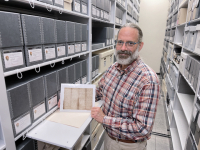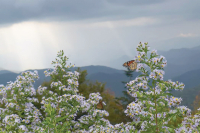Pride of the Mountains band and receives marching’s highest honor
Western Carolina University’s Pride of the Mountains Marching Band has been awarded the prestigious Sudler Trophy, the nation’s highest and most-coveted award for college and university marching bands.
Formal presentation of the award, which has been called the “Heisman Trophy” of the collegiate marching band world, was held at halftime of WCU’s home football game against Wofford College on Oct. 24.
Western Carolina is the first institution in the state of North Carolina and the first member of the Southern Conference selected for the award. Past recipients of the honor include the universities of Texas, Michigan, Illinois, Nebraska, Kansas, Oklahoma and Alabama, and Ohio State, Louisiana State, Penn State and Auburn universities.
Established in 1982, the trophy is presented to a college or university marching band that has demonstrated the highest of musical standards and innovative marching routines and ideas, and which has made important contributions to the advancement of the performance standards of college marching bands over a number of years.
WCU Chancellor John Bardo said the award is especially meaningful because it recognizes an extended record of excellence achieved by the Pride of the Mountains Marching Band under the leadership of band director Bob Buckner. Bardo called the band “one of the most important emissaries of WCU for more than a decade.”
The Pride of the Mountains is widely regarded as one of the top marching bands in the Southeast for its elaborate field shows. Often called “the world’s largest funk-rock band,” the unit performs a crowd-pleasing medley of up-tempo pop tunes, with electric guitars, singers and other musical elements not typically associated with marching bands.
The 360-member Pride of the Mountains Marching Band is performing an entirely new show in 2009 – “Born to Be Alive,” featuring the music of the Black Eyed Peas, Pearl Jam, Kanye West, Michael Jackson, the Bee Gees, Maroon 5 and Patrick Hernandez.
For more information about the Pride of the Mountains, visit www.prideofthemountains.com or call 828.227.2259.
High school bands compete at WCU
Western Carolina’s Pride of the Mountains Marching Band recently hosted the Tournament of Champions annual invitational competition. Each year, more than 3,000 high school musicians from Tennessee, Virginia, and North and South Carolina come to E.J. Whitmire Stadium at Western Carolina to compete. Twenty-two bands from across the Southeast took part in this year’s event. Carl Harrison High School marching band of Kennesaw, Ga., was named grand champion. Pisgah High School of Canton took second place in Class A. Tuscola High School of Waynesville also competed.
WCU raises $50 million for endowment
Western Carolina University last week announced that the first comprehensive fundraising campaign in university history has netted a grand total of $51,826,915 in private giving for endowed scholarships, professorships and programmatic support.
The tally is more than $11 million above the $40 million goal announced when the campaign was publicly launched in February 2007.
“We have come further and progressed faster than we could have imagined when this campaign began,” WCU Chancellor John W. Bardo said. “Not only have we reached our goal, but we have far exceeded it. We had hoped to be able to raise $40 million by 2010, and here we are announcing more than $51 million on Oct. 15, 2009, a most historic day in the life of our university.”
Thirty-four percent of the amount raised in the campaign will go toward endowed professorships, which allow the university to attract accomplished scholars in a variety of academic disciplines. Thirty percent of the dollars raised will fund merit-based scholarships that will help WCU recruit highly qualified students, while 26 percent will be directed to current use initiatives such as the Loyalty Fund and Catamount Club, and 10 percent to programmatic endowed funds for academics, athletics and other university needs.
Borrowing bikes a big hit at university
Ever since the launch of the Yellow Bike Project in late August, a new bike culture has quickly sprung up around campus at Western Carolina University.
The student-led initiative, which makes a fleet of fixed-up bikes available to anyone who wants to get around campus, has worked well under an honor system.
Chris Holden, co-president of the WCU Cycling Club, said he and the other organizers had anticipated that some of the bikes would go missing, but said he hadn’t seen any bikes leave campus so far. Moreover, students seem to be respectful toward their borrowed rides.
“I see people trying to take care of the bikes. I haven’t seen people trying to beat them up,” Holden said.
Sophomore Jimmy Pease said he had used yellow bikes about 30 times before they had been out for even a week.
“I love it,” said Pease. “I will honestly look for one of these things rather than walking.”
Holden said within the first 10 minutes of the first day, he saw three people already riding by on the bikes, which operate on a first-come, first-serve basis.
“They’re a hot commodity,” said Holden.
The project’s success can be attributed to the hard work of three students: Stephen Benson, who graduated from WCU earlier this year, along with Holden and Zach Heaton, the other co-president of the WCU Cycling Club. The trio worked for nearly a year collecting donated bikes, many from the police impound on campus, and making repairs.
The final step was spray painting the bikes yellow, a color chosen because of its visibility and closeness to gold, one of WCU’s school colors.
Holden hopes the project will promote an active, healthy lifestyle, as well as provide a benefit to the environment by reducing the amount of driving on campus.
Benson’s other goal is to bring bicycles to anyone in the WCU community who has always wanted one.
“I have a lot of friends who want to get into biking. They just cannot afford a bike to ride,” Benson said. “This is a good way for people who don’t want to invest in a bike to have the opportunity to ride and figure out if they like it.”
Although there are about 10 bikes out on campus now, Holden hopes to see a fleet of 30 or 40 by the end of the year.
The program has already received an influx of donated bikes.
Despite the popularity of these yellow bikes, they aren’t exactly in excellent condition.
A sticker on the bike lets riders know what number to dial if any maintenance is required. Holden said within the first week, he received calls about flat tires and tune-ups. One bike lasted a mere 5 minutes after being launched.
While Pease said he wishes the bikes were in better condition, he is grateful that they are even available.
“These are perfect for what you need,” said Pease.
Player death prompts sickle cell testing for Western Carolina student athletes
Western Carolina University has enacted mandatory testing for the sickle cell trait among all student athletes following the death of a football player during summer workout drills in July.
Ja’Quayvin Smalls, a junior defensive back from Mount Pleasant, S.C., was in excellent physical condition. The afternoon was not abnormally hot, nor were the drills particularly exhausting. The lack of other explanations points to the presence of the sickle-cell trait as the cause of Smalls’ death, though an autopsy is not complete.
The underlying presence of the sickle cell trait is a leading cause of death among college football players. Colleges are increasingly testing athletes for the trait, although WCU is at the forefront of the movement for schools of its size.
The trait can strike under heavy exertion and clogs the passage of blood cells through arteries. Cramping is a telltale sign of the onset of a sickle cell attack.
Smalls had complained of cramps during the workout and was taken to the sidelines under the care of an athletic trainer. Just minutes later, Smalls quit breathing. Trainers performed CPR until paramedics arrived, but Smalls was pronounced dead an hour later at Harris Regional Hospital.
“This has been a very emotional experience for all of us,” said Chip Smith, the athletic director at WCU. “It has made a difference in how we look at football and how we look at each other.”
WCU Chancellor John Bardo said the character of the players on the team has been exceptional through the tragedy.
“I don’t care whether they win a game honestly,” Bardo said.
Several team members who came to the hospital following Smalls’s collapse joined in impromptu prayer when he was pronounced dead. The entire football team traveled to Charleston for his funeral. His headstone is being engraved with a WCU logo at the request of his family.
The sickle cell trait is found in one of 12 African Americans. WCU will test all student athletes regardless of race, however.
The blood test costs $10 per athlete. WCU has 330 student athletes across all sports. This year, the school will test all of them. In future years, only incoming athletes will be tested.
Students who test positive for the trait won’t be barred from the field.
“You can’t deny them the opportunity to play,” Smith said. “They can make an informed choice and decide for themselves whether to participate.”
Coaches and trainers will know which students have the trait, but will keep it a secret from the rest of the team. The first five days of team training will be less strenuous, giving the athletes a chance to acclimatize since the attacks are more prevalent during periods of high stress, Smith said.
The number of schools that test for the trait has increased in recent years, with more than 70 percent of conference schools testing for the trait. Among schools the size of Western, the number is far less.
The NCAA this summer adopted guidelines recommending that all student athletes be tested for the trait. The policy shift was prompted by a lawsuit against the NCAA by the family of a Rice University football player who died during practice in 2006 from a sickle cell attack.
The National Athletic Trainers’ Association has advocated for the mandatory testing of student athletes since 2007.
WCU welcomes freshman class
Probably very little about freshmen move-in day at Western Carolina University has changed over the years: the “nervous but excited” students, the teary-eyed, mostly just nervous parents following close behind, the authoritative, no-nonsense Resident Advisors directing their new underlings, and of course, the rows of suitcases and cardboard boxes lining the sidewalks. Adding to the usual excitement of move-in day this year, WCU premiered a brand new four-story 426-bed dormitory that will predominantly house Honors College students and Teaching Fellows program participants.
Balsam Hall is part of a two-building complex where a total of about 800 students will reside. The other section, Blue Ridge Hall, has yet to be completed and is scheduled to open next fall. The cost of the complex was about $50 million.
The dorm, which students helped design, features plenty of study rooms, common areas with kitchens, offices for Honors College staff, and meeting rooms. Also new to the campus is Courtyard Dining Hall, a $17.6 million, 53,000-square-foot building.
Jeremy Cauley, a graduate of Smoky Mountain High School, is one of Balsam Hall’s first residents. A recipient of a teaching fellowship, he plans on majoring in history with a minor in physical education.
Cauley, who is rooming with one of his best friends from high school, said he looked forward to starting college life, beginning with setting up his room.
“I can’t wait to get everything where it’s supposed to be,” he said.
Marty Cauley, his father, said he knew Jeremy would be back home in Sylva sooner or later.
“For laundry if nothing else,” he said. “I try not to look at the baby pictures. It doesn’t help.”
James Hinnant, a WCU junior and vice president of the Leadership Institute, has been volunteering to help freshmen move in since he himself was a freshman. As a member of the Institute, he moved in a few days earlier to help out freshmen on WCU’s official move-in day. Hinnant said he mostly knows what to expect by now.
“I know the fridges are gonna be there,” he said. “It seems like those are getting bigger every year.”
Hannah Painter, an 18-year- old freshman from Sylva, found a welcome surprise when she moved into Balsam Hall: a private room with an adjoined bathroom that she’ll share with only one other girl.
“Wow! Nice,” Painter said, as she walked in for the first time. “Being a freshman, it’s nice to have your own room.” Painter, whose parents, grandparents and siblings all graduated from WCU, said her room was “way better” than she expected.
Across the street in Scott Hall, Monica Gatti, a WCU freshman from Nantahala, said she chose to attend WCU because it was nearby and had a great teaching program. As valedictorian of her high school class, Gatti experienced the added excitement of receiving a free laptop on move-in day.
According to Gatti, move-in day at the university had been very well-organized.
“The only thing I’m afraid of doing is getting lost,” she said. “I have a map. That’s gonna be my lifeline.”
Her mother Cindy Gatti said she would leave the campus feeling much less nervous than when she first arrived.
“I feel very secure now that I’m here,” she said. “Everyone’s been very friendly and supportive.”
WCU By the numbers
Freshman class
Applications 12,375
Admitted 5,458
Enrolled (As of Aug. 19) 1,535
High School Academic Profile
Average Weighted GPA 3.44
Average SAT Combined 1,034
Average ACT 21
Gender
Male 45.4%
Female 54.6%
From 22 states and 11 foreign countries
WCU ranks highly among master’s degree universities
The latest U.S. News & World Report guide to “America’s Best Colleges” ranks Western Carolina University 10th among public universities in the South that offer master’s degrees.
It is the first time WCU has made the U.S. News top 10 list of Southern public master’s institutions.
“Western Carolina has moved steadily up the rankings over the past few years, and we are glad to see that trend continue again this year,” said WCU Chancellor John Bardo. “In recent years, our College of Education and Allied Professions has received two major national honors, and our academic programs in business administration, project management, criminal justice and entrepreneurship have earned high national rankings.”
Still, Bardo cautioned prospective students against putting too much stock in rankings when they are making the important decision of where to go to college. “After students narrow down their list of prospective colleges to a handful, they should visit the various campuses to get a feel about which one is right for them,” he said.
WCU representatives will hold open house sessions on the Cullowhee campus to allow prospective students to do just that on Oct. 3, Nov. 14, Feb. 17 and April 17.
For information about those events and other information about undergraduate and graduate admissions at WCU, visit admissions.wcu.edu.
WCU partners with Dillsboro
Western Carolina University has entered into a partnership with the municipality of Dillsboro to provide assistance in building the town’s economy after the recent departure of the Great Smoky Mountains Railroad.
WCU has become involved with the town through its Quality Enhancement Plan, an effort to enhance undergraduate education by linking student experiences in and out of the classroom, and its responses to UNC Tomorrow, a university system initiative to help solve critical statewide problems.
“What a tremendous opportunity this gives the students, and the citizens and the merchants of Dillsboro,” said Mayor Jean Hartbarger.
WCU Chancellor John Bardo said the university will recruit students who are academically prepared, conduct a strategic program analysis of all academic programs and examine the structure of the university to ensure the university is well-positioned to provide assistance to surrounding communities.
The university will try to emphasize quality in spite of an 8 percent budget cut of approximately $8 million, and the loss of 92 positions last fiscal year, Bardo said. Although the majority of those eliminated positions were vacant, about 31 of them were filled. “The WCU family was hurt by the state budget situation,” Bardo said. “All of us have had to take furloughs. We have had to lay off members of the family, and that hurts.”
The university is facing an additional $200,000 in cuts but can manage those without additional layoffs, he said
WCU braces for housing crunch in face of growth, construction delays
Come the start of fall semester, some Western Carolina University freshmen could find themselves residing in unusual living quarters.
A delay in the construction of a new residence hall is forcing WCU staff to scramble for places to put incoming students — and solutions range from creative to cramped.
Balsam Hall, which will house 426 students, including members of the university’s honors program, was supposed to be completed Aug. 1 after a year-and-a-half construction process. But on Aug. 21 — freshman move-in day — just 236 beds will be ready for students, putting about 200 freshmen in a bit of a bind.
“I haven’t yet given up hope it’s going to make it on time, but we have to look at what’s most likely,” said Keith Corzine, director of residential living for the university.
The construction of Balsam Hall is the first phase of a two-phase $50 million project, which will also include the construction of the similar-sized Blue Ridge Residence Hall. The buildings will be the most state-of-the-art dormitories on campus, featuring bathrooms shared by just two students, study spaces, public kitchens and lobbies.
“From the quality of life perspective, it’s a huge gain,” Corzine said.
But the very likely scenario is that phase one of the project, Balsam Hall, won’t be finished on time. Corzine attributes the hold up to a number of construction factors, including delays at critical times and unforeseen challenges with structural work. May was one of the wettest months on record in recent years, Corzine said, which didn’t help things.
“I think we worked through a variety of issues,” he said.
That means making other arrangements for students, hopefully temporarily.
“We think there’s a really strong possibility that anybody inconvenienced by not being able to get in on time would be able to get in around Labor Day, so any inconvenience would be limited to a matter of a couple of weeks,” Corzine said.
Corzine said the university hasn’t decided just where it will house students. One option is Madison Hall, typically used to house graduate students and conference attendees. Grad students could be relocated within the building, Corzine said, and single rooms normally used for conference-goers could be doubled up to house more than one student. Reconfiguring Madison Hall would gain about 70 extra beds, he said.
To find more space, the university will have to get creative. That could likely mean converting study rooms into bedrooms, which the university has done in the past, or temporarily putting two or even three students in single rooms. Corzine realizes, however, that such cramped conditions can be particularly overwhelming for freshman already trying to adjust to life away from home.
“I prefer not to triple it if I can help it,” he said. “You’re going to be putting people in situations with roommates that they most likely don’t know.”
Corzine says he wants to make clear “that the spaces we would put people in would be adequate and as comfortable as we could make them.”
The university will likely cut a financial break to students housed in temporary locations.
“We’ll certainly be looking at the possibility of crediting those students who have been truly inconvenienced, more than likely a pro-rated amount of their housing costs,” said Corzine.
Finishing Balsam Hall by Labor Day will rely on a smooth flow of construction from here on out.
“If everything in the last month-and-a-half breaks just right, if they make up time, and we don’t have any additional delays, then we’re going to be really close with delivering most all the building,” said Corzine. “If you get a delay here or there on something, it’s going to certainly compromise our ability to finish on time.”
Growing pains
The university has confronted a student shuffle before. Just last year, the 400-bed Leatherwood Residence Hall was torn down to make way for Balsam Hall and another residence hall that will be built beside it. Students lived in Leatherwood for half the year, then were relocated to empty rooms for the second semester.
“We were able to absorb them mid-year somewhere else,” said Corzine. “That hit us at a point where on-campus demand wasn’t great enough for us to be in a situation like we are in now.”
Corzine listed several factors that have contributed to the lack of space on WCU’s campus, including an increase in the number of sophomores, juniors and seniors who want to live on campus. The lack of off-campus housing in the Cullowhee area is one factor in the number of students seeking dorm rooms.
More than one-third of the university’s student population lives in on-campus housing — 3,475 out of a projected 9,400 this fall. The demand was so great that the university started a waiting list for on-campus housing at the end of last semester.
“We chose to take a position that we could put them on a wait list, but we couldn’t guarantee them housing after that point,” said Corzine.
Record enrollment numbers at WCU could squeeze space even further, according to information presented at a recent board of trustees meeting. The university anticipates between 9,300 and 9,500 enrolled students in the fall of 2009, compared to 9,050 at the same time last year. Applications to the college have soared from 4,500 two years ago to 12,400 this year.
The freshman class is growing particularly quickly, with 1,550 expected this fall, up from 1,219 just last year. Indeed, the university stopped taking tuition deposits from freshmen and instated a waiting list for incoming students for the first time in its history.
Corzine said he doesn’t necessarily mind the challenges growth has and will likely continue to present to university housing. In fact, it’s important to keep WCU residences close to full so that the housing department can continue to fund projects.
“From our perspective, growth is important because we’re self-supporting. We’re an auxiliary service and generate our own revenue,” explained Corzine. “It’s important that we have occupancy rates that are high, so we generate enough money to pay for our costs but also to pay debt on new projects and plan for new projects.”
Still, a shortage of space isn’t an easy situation to navigate.
“We want to be close to full, but obviously any delay creates an issue we’re going to have to work through,” Corzine said. “There’s been a lot of grey hairs over this one.”
Preparations
The university is stepping up to accommodate growth. Two old residence halls were demolished to make way for the Balsam and Blue Ridge residence halls, which are among the first parts of a long-range campus master plan.
“We basically had an opportunity to redesign the heart of campus and truly enhance it for generations to come,” said Corzine. A new campus dining hall near the dorms is also nearing completion.
Next up is a redesign of the high-rise Harrell Residence Hall, built in the early 1970s. Harrell will be taken off-line in the fall of 2011 for a major renovation. Over the next seven or eight years, a total of three high rises will be renovated, or about 1,500 beds. Making sure there’s still enough space for students while the buildings are being redone will be a juggling act.
“We’ll have to do them incrementally, and we’ll have to maintain the same basic capacity that we have right now unless we choose to build another building,” Corzine said.
Adding more space for campus housing isn’t out of the question, especially if WCU continues to break enrollment records.
“If our admissions data were to show that we are going to consistently have huge incoming first-year classes, then I think certainly we would have to look at our options and talk about whether we’d want to expand,” Corzine said.
Craft Revival Project receives funding from Cherokee foundation
The Cherokee Preservation Foundation recently awarded $87,700 to Western Carolina University’s Craft Revival Project to continue the university’s Cherokee crafts documentation project.
Following its initial year, which explored Cherokee baskets and basket makers, the second year of the project will focus on Cherokee potters and pottery during the first part of the 20th century. The project includes research on handcrafts made by tribal elders at the Museum of the Cherokee Indian and Qualla Arts and Crafts Mutual.
The project’s primary goals are to provide documentation of early 20th-century Cherokee pottery, disseminate new educational information, build an online database of images and develop lesson plans to promote a better understanding of the role and impact of Cherokee crafts in Western North Carolina.
With the funding, the project staff will create a museum-level inventory system of the permanent collection at Qualla Arts and Crafts, photograph pottery in the collections, scan historic photographs of potters and pottery, and create individual records for each item photographed and scanned. In addition, the project staff will document the lives of the potter elders. The project plan also includes printing copies of a guidebook on Cherokee pottery. The guidebook follows one on Cherokee baskets and is second in the “From the Hands of Our Elders” series.
For more information about the project contact Anna Fariello at 828.227.2499 or This email address is being protected from spambots. You need JavaScript enabled to view it..
Bardo declines nomination
Western Carolina University Chancellor John Bardo will not be among the pool of candidates being considered for president of the University of Cincinnati, he announced at a university board of trustees meeting June 5.
The fact that his name was among those under consideration had come as a surprise to Bardo, an alumni of the school. Bardo’s name appeared on a list of candidates compiled by the presidential search committee at Cincinnati.
“I did not ask to be nominated and did not apply,” Bardo said.
Bardo said he was honored to be considered by the search committee, and added that the decision to apply for a top position as president of another university was a serious one.
“This is not like moving from Burger King to Hardees working the cash register,” Bardo told the board of trustees. “If you’re in a role like this, you have to think seriously about applying for a position.”
At this point in time, however, leaving WCU is not something Bardo would consider, he said.
“I’m not going to think about that right now. What I am going to think about is WCU, the budget, and serving the people of this great state,” said Bardo.
Survey sheds light on WCU student vision for Cullowhee
What’s a college without a college town?
It’s an almost unimaginable scenario to those who love the unique, quirky places that grow up around major universities. But it’s very much the reality when it comes to Western Carolina University and the community that houses it, Cullowhee.
Despite its proximity to the college, students hardly frequent the commercial district. Not that there’s much to draw people in — a Mexican restaurant, a Chinese restaurant, a barber and an auto repair shop are about the only things there, and the storefronts badly need an update.
“It’s an eyesore,” says Chris Blake, a WCU assistant English professor and co-chair of the group Cullowhee Revitalization Endeavor (CuRvE). “If you drive through, you’ll see a number of broken signs. There are no sidewalks, no streetlights. Cullowhee is dark at night.”
The community’s appearance is a major deterrent to potential student business that’s just a stone’s throw away.
“Cullowhee is the backdoor of Western, and there is right now a disconnect between the university and the town,” says Blake. “Students don’t go to Cullowhee to do much at all.”
CuRvE’s goal is to help breathe some life back into the community. But where to begin?
“What would students like to see in Cullowhee, and what would bring them down to the area?” Blake’s group asked themselves. “We want to revitalize Cullowhee, but to do so, we need to know what it would take and what kind of changes they want to be made. If we can’t get students involved, I don’t know if it can happen.”
Enter political science professor Todd Collins. Together, the men came up with an idea to survey the student body and ask what they’d like to see in Cullowhee.
“We had been needing the data for some time, and we just did not have the means to collect it or the resources to do so,” says Blake. “Todd had the perfect connection, because his group of students is involved in survey work. This was the perfect fit.”
Collins’ students were game. They knew firsthand how students felt about Cullowhee.
“We get Chinese takeout every once in a while and we love (the Mexican restaurant), but other than that, we don’t really spend much time down there,” said Caroline Wright, a sophomore political science major. “We don’t even really drive that way.”
Collins’ classes created a 26-question survey to gauge just how students felt Cullowhee could be improved.
“We thought about what questions we wanted to be asked,” says Katy Elders, also a sophomore political science major.
Asking the students what they wanted out of Cullowhee was an approach that hadn’t been tried before.
“This is the first time anybody had tried to do any survey of the student body as a whole, and reach out and talk to students collectively,” says Collins.
Students speak
The response was overwhelming. Close to 1,100 took part in the survey, which was sent out through email. It was totally voluntary — students didn’t get a prize for participating.
“I was shocked,” said Elders. “There was more response than we’ve had for other surveys on campus.”
“I was really surprised by the number of people who had things to say other than, ‘I want a bar, or ‘I want a Burger King,’” Elders says. “There were some really long, really well-developed answers, with many people saying we like the way that Cullowhee is, and we don’t want it to lose its small-town appeal.”
The survey shed some light on how often students frequent Cullowhee businesses and their opinions about the area’s current state.
Students overwhelmingly felt that Cullowhee’s appearance could use an overhaul. About 70 percent said the appearance of businesses and buildings “needs lots of improvement,” while close to zero said that it “needs no improvement.”
Some students wrote that they didn’t feel safe in the area.
“Some said they’re afraid to go there at night because it’s dark, and not well lit,” said Collins.
When asked how frequently students use the businesses in Old Cullowhee, just 11.5 percent said they do so weekly. Most students — 32 percent — said they never use the town’s businesses. Of those who live on campus, closest to the Cullowhee commercial district, 38 percent never go there.
Yet students would be willing to go to the area if there was something to offer. Seventy-two percent said they’d frequent the area weekly if new businesses were developed there.
Simply improving the area’s appearance will attract students, according to the survey.
“Students said they’d be twice as likely to use businesses if they were just cleaned up,” Elders says.
An improved look could have further-reaching benefits, students seemed to think.
“A lot of students mentioned that they thought a nicer Cullowhee area would help with student retention, and keeping students around here on weekends,” says Collins. “It also may provide more jobs.”
Smart growth
But although students indicated they’d like more offerings in Cullowhee, they’re picky about what businesses set up shop in town.
A surprising number preached smart growth, and said they don’t want to see chain stores come to the area.
“A lot of students mentioned smart growth,” says Collins. “They didn’t want huge chains and strip malls. A lot of people mentioned trying to keep the small-town feel of the area.”
Such opinions are in contrast to Chancellor John Bardo’s proposed plan to construct a “town center,” retail complex with shops, restaurants, entertainment venues and other businesses on 22 acres of WCU’s property. Bardo has mentioned the possibility of chains like Barnes and Noble and Moe’s Southwest Grill coming to the town center.
Faculty protested the idea of major chains inhabiting Cullowhee, saying such stores could make it harder for small, local businesses to survive. Elders, like many other students, shares faculty concern about the impact of chain stores.
“I personally don’t want to see a Chili’s or Applebee’s,” she said. “I think we already have a unique set of restaurants and shops here.”
Blake stressed that Cullowhee’s identity needs to be determined by the people that live there, not an outside corporation.
“Someone could come in from outside and say we’ll make this into a town that may not have the flavor of what Cullowhee is,” he says. “The identity needs to be unique to Cullowhee, not what someone thinks Cullowhee should be.”
The issue of alcohol proved to be divisive in the survey, largely because of the chain stores that could follow. Cullowhee is dry, and needs to incorporate as a town before it can allow alcohol to be served there. The survey didn’t specifically ask about bars or alcohol. It did ask students if they favored incorporation. The majority was in favor of it, and Collins thinks that was because they support bringing alcohol to the community.
In responses to open-ended questions, many students wrote about their desire to see bars in Cullowhee. Others opposed it, and the survey revealed two camps on either side of the issue.
“You have your whole big group that really wanted incorporation because they really want alcohol, and a bunch of people who want to see local businesses as opposed to chain restaurants and stores,” said Wright.
More outdoors
A number of students advocated taking advantage of what’s already there — namely, the area’s natural resources — and placing more of a focus on recreation.
Elders says that surprised her.
“There was a significant amount in favor of recreation activities, which I didn’t anticipate would equal the desire for restaurants and other businesses,” she says. “A lot of students are interested in hiking, tubing, and fishing.”
Specifically, many students expressed desire for better access to the Tuckasegee River that runs next to WCU’s campus. Currently, one must traipse through a hill of rocks and brush to get down to the river. An access point could allow for a canoe put-in, swimming, tubing and fishing in a convenient location. Elders says she and her friends routinely drive 20 or 30 minutes out of town for places to swim and fish.
Improving river access has been a long-held desire of CuRvE’s.
“Right now, students don’t use the river,” says Blake. “We have the potential to have something very similar to Cherokee, but it will take quit a bit of money.” The Oconaluftee River that runs through the nearby Cherokee Indian Reservation is a popular fishing and wading spot.
Tool for change
The survey results, the first of their kind, have the potential to be a powerful tool.
For example, said Collins, they could influence businesses to clean up their buildings, or they could help a business decide to relocate to the area by showing the untapped market that resides there. Or if a group is applying for grants to fund parks or greenways, the results are evidence of the number of people who would use them.
Plans are in the works for a second round of surveying, this time of residents in the area. For now, the survey seems to have prompted students to get on board. Many of them wrote that they’d like to volunteer in any revitalization effort.
“I just really hope that people realize we actually do care about what’s going on in the area, and that we’re not just stereotypical college students who only want to hang out and party,” Wright said.
She added that she’s personally optimistic about Cullowhee’s potential.
“It could use a little help, but I really do think that it has the potential to be a really cool little place in the mountains.”









